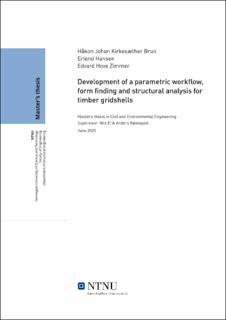| dc.contributor.advisor | Rønnquist, Nils Erik Anders | |
| dc.contributor.advisor | Dyvik, Steinar Hillersøy | |
| dc.contributor.author | Zimmer, Edvard Hove | |
| dc.contributor.author | Hansen, Erlend | |
| dc.contributor.author | Brun, Håkon Johan Kirkesæther | |
| dc.date.accessioned | 2021-09-21T16:09:37Z | |
| dc.date.available | 2021-09-21T16:09:37Z | |
| dc.date.issued | 2020 | |
| dc.identifier | no.ntnu:inspera:56731605:25761536 | |
| dc.identifier.uri | https://hdl.handle.net/11250/2780006 | |
| dc.description.abstract | I denne avhandlingen blir potensialet til de parametriske arbeidsflytmiljøene for sanntids konseptuell design og analyse av diskrete, segmenterte gitterskall i tre undersøkt. Mulighetene for å generere repeterende nodenettverk, uten at det går ut over konstruksjonsytelsen i stor grad, blir også undersøkt. Tre som materiale er populært i Norge på grunn av dets bærekraft, lette vekt og tilgjengelighet. Det, kombinert med muligheten for å masseprodusere noen av de ellers unike konfigurasjonene av byggematerialer som trengs, kan gjøre gitterskall til mer gjennomførbare konstruksjoner, også i Norge. Dette undersøkes gjennom utviklingen av et parametrisk arbeidsflytmiljø der gittermønsterdesign og tilbakemeldinger i sanntid er kombineres med egenutviklede komponenter for både global og lokal geometrisk formfinning. Oppgaven ledes frem til et studieprosjekt der the Great Court Roof, taket til British Museum, blir lagt som grunnlag for redesign og optimalisering av gitterskall.
Det parametriske arbeidsflytmiljøet viste seg ikke bare å være nyttig, men avgjørende for gjennomføre studieprosjektet. For the Great Court Roof ble nodevekten funnet å være ubetydelig sammenlignet med andre laster. Konstruksjonsytelsen avhenger i stor grad av den globale formen, og det ble funnet at the Great Court Roof ikke er optimalisert for konstruksjonseffektivitet. Det blir vist hvordan gitterskalls konstruksjonseffektivitet påvirkes av kurvatur, og at en økning i høyden på the Great Court Roof kan gjøre konstruksjonen mer effektiv og gi mindre nedbøyninger. Topologien viste seg også å påvirke konstruksjonsytelsen i stor grad. Det ble funnet at nye gittermønstre enkelt kan gjøres i et parametrisk arbeidsflytmiljø, men de asymmetriske grensebetingelsene som kommer med the Great Court Roof gjør det vanskeligere å finne et design som gir økt repetisjon av nodenettverk. Det ble funnet at tilrettelegging av enten en effektiv konstruksjon eller en konstruksjon som er enklere å produsere, vil til en viss grad gå ut over den andre. | |
| dc.description.abstract | In this thesis, the potential of the parametric workflow environments for real time conceptual design and analysis of discrete, segmented timber gridshells, is investigated. The opportunities of generating repeating node networks in the design, without compromising the structural performance to a large extent, is also examined. Timber has become a popular material to use in Norway, due to its sustainability, light weight and availability. This combined with the possibility to mass produce some of the otherwise unique configurations of building materials needed, could make gridshells a more viable structure, also in Norway. This is investigated through the development of a parametric workflow environment where grid pattern design and real time feedback of structural behaviour is combined with custom developed components for both global and local geometrical form finding and evaluation. The culmination of the thesis is a case project in which the Great Court Roof of the British Museum served as the basis for redesigns and optimization.
The parametric design environment developed proved not only useful, but crucial for any of the design comparisons of the case project to be made. For the Great Court Roof, the weight of the nodes was found to be negligible compared to the other loads acting on it. The structural performance greatly depends on the global shape, and it was found that the Great Court Roof is not optimized for structural efficiency in terms of curvature. It was shown how the structural efficiency of gridshells are completely dependent upon its curvature, and how increasing the height of the Great Court Roof make a stronger structure that deflects less. The grid pattern topology turned also out to greatly affect the structural performance. It was found that generating new grid patterns can be done quickly with parametric design, but irregular boundaries can make it more difficult to find a design that facilitates repeating node networks. It was found that facilitating either an effective structure or one easier to manufacture, will to at least some degree involve compromising the other. | |
| dc.language | | |
| dc.publisher | NTNU | |
| dc.title | Development of a parametric workflow, form finding and structural analysis for timber gridshells | |
| dc.type | Master thesis | |
